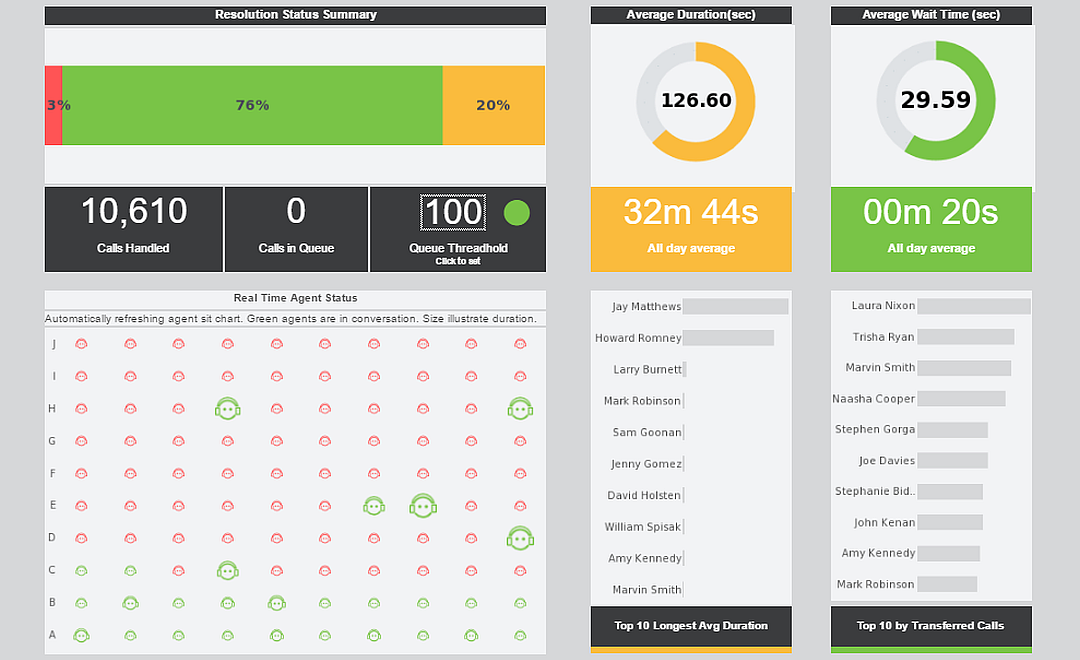Segmenting Callers into Clusters
Below is the continuation of a transcript of a Webinar hosted by InetSoft on the topic of "Performance Management in Government." The presenter is Christopher Wren, Principal Consultant at GPM.
Christopher Wren (CR): Let me just show you one more interesting angle on this. So this is another call center that we have been working with, and in this case the theory was that the lower you could bring down average talk time the happier the citizens would be. These are people calling about their benefits, and the belief was currently they are on the phone too long, and no one wants to be on the phone with the state government any longer than they have to be, so we really need to bring this talk time down as low as possible.
Well then we look at the data and as you can see something interesting about it which was that satisfaction was pretty high with short calls, and then you can see satisfaction takes a dip as people stay on the phone past about 2.5 minutes. People start being less and less satisfied. But then something very strange happened, which is at about 3 minutes 12 seconds or so, satisfaction started going up again, and this is a real mystery.
 |
Read how InetSoft saves money and resources with deployment flexibility. |
What was this telling them? So we disaggregated the data, or in other words tried to segment the callers into clusters of certain similar characteristics. What you can see here is that there were really two different kinds of people calling. There were what we call the angry calls, or people who had just some quick complaints, something they wanted to be resolved, maybe their address was wrong, either the name was misspelled, whatever it was. There were these quick calls. And so these people who just want to get on the phone and get off the phone.
But there was another group of people that they hadn’t really thought about, yet. And those were others who need more care. These are what we were calling the desperate requests. People who had a longer story and needed to really get their story out. They were more complex. They needed to stay on the phone longer, and with these people you didn’t want to cut them off early. So with these people after about three and a half minutes their satisfaction went up and stayed high even as they stayed on the phone for four minutes.
So really what we are trying to tell you here is that one target is not necessarily right for all situations. De-aggregate your data. Look at the data in a little bit more sophisticated way, and you can start to break it apart and see, well gosh there really are two different groups here so we need two different targets, one target for the kind of people who want to get off the phone quickly, one target for more complicated calls. Different stories require different targets and different performance metrics.
 |
Read the top 10 reasons for selecting InetSoft as your BI partner. |
What Are All the Types of Clusters of People Calling into a Customer Care Center?
Customer care centers typically handle a diverse range of calls from various types of customers, each with unique needs, concerns, and preferences. While the specific types of clusters of people calling into a customer care center may vary depending on the industry, product, or service being offered, here are some common categories:
-
General Inquiries: Customers calling for general information about products, services, policies, or procedures. These callers may have questions about product features, pricing, availability, or account management.
-
Technical Support: Customers seeking assistance with technical issues, troubleshooting, or product malfunctions. These callers may require guidance with software installations, device configurations, or resolving hardware/software compatibility issues.
-
Billing and Payments: Customers contacting the customer care center to inquire about billing statements, payment options, account balances, or payment discrepancies. These callers may need assistance with billing inquiries, payment processing, or setting up payment plans.
-
Product Support and Warranty Claims: Customers experiencing product defects, damages, or warranty issues. These callers may require assistance with product returns, exchanges, repairs, or filing warranty claims.
-
Order Status and Tracking: Customers inquiring about the status of their orders, shipments, or deliveries. These callers may want to track their packages, request updates on order processing, or address issues with delayed or missing shipments.
-
Complaints and Escalations: Customers expressing dissatisfaction with products, services, or interactions with the company. These callers may have experienced issues such as poor service quality, delivery delays, billing errors, or product dissatisfaction.
-
Sales and Upgrades: Customers interested in purchasing additional products, upgrading existing services, or exploring new offers and promotions. These callers may be seeking information about product upgrades, subscription renewals, or bundle deals.
-
Account Management: Customers needing assistance with account-related tasks such as account setup, password resets, account closures, or updating account information.
-
Feedback and Suggestions: Customers providing feedback, suggestions, or testimonials about their experiences with the company's products, services, or customer care. These callers may offer insights into areas for improvement or share positive experiences.
-
Special Requests and Customizations: Customers with unique or specialized requests that require personalized assistance or accommodations. These callers may be seeking customizations, modifications, or special arrangements not typically offered through standard services.
-
Promotions and Marketing Campaigns: Customers responding to promotional offers, marketing campaigns, or advertisements. These callers may be interested in redeeming discounts, participating in loyalty programs, or learning more about special promotions.
-
Language and Accessibility Support: Customers requiring language assistance or accommodations for accessibility needs. These callers may prefer communication in a specific language, require translation services, or need assistance with accessible communication options.
| Previous: Example of an Advanced Visualization |
Next: Mobile
BI
|
